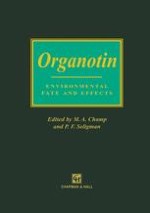1996 | OriginalPaper | Chapter
Tributyltin Concentrations in Water, Sediment, and Bivalve Tissues From San Diego Bay and Hawaiian Harbors
Authors : Joseph G. Grovhoug, Roy L. Fransham, Aldis O. Valkirs, Bradley M. Davidson
Published in: Organotin
Publisher: Springer Netherlands
Included in: Professional Book Archive
Activate our intelligent search to find suitable subject content or patents.
Select sections of text to find matching patents with Artificial Intelligence. powered by
Select sections of text to find additional relevant content using AI-assisted search. powered by
During the period of 1986 through 1989, tributyltin (TBT) levels in San Diego Bay (California, USA) surface waters averaged 4.7–13 ng l-1 in the north bay, 1.3–9.9 ng l-1 in the south bay, and 3.5–14 ng l-1 in US Navy pier regions. TBT concentrations in the surface water of yacht harbors averaged 19–120 ng l-1, while concentrations in bottom waters ranged from 8.8 to 61 ng l-1. Yacht harbors and the naval pier regions showed a decline in TBT concentrations in water since restrictive paint-use legislation was enacted in January 1988. Average TBT concentrations in sediment in San Diego Bay ranged from 1.7 to 1100 ng g-1 (dry weight) with higher values in yacht harbors adjacent to vessel repair and maintenance facilities. TBT concentrations in bottom water <60 ng l-1 correlated well with concentrations in sediment. In regions where TBT levels in bottom waters were <30 ng l-1, TBT levels in sediment were highly variable. TBT concentrations in sediment were generally highest in yacht harbors but did not exhibit significant temporal decreases coincident with restrictive legislation on TBT use. TBT burdens in tissues of the bay mussel (Mytilus edulus) in San Diego Bay ranged from 32 to 2100 ng g-1 (wet wt); with bioaccumulation factors (BAF) ranging from 2.8 × 103 to 6.6 × 104. BAF decreased rapidly as TBT concentrations in surface water approached or exceeded 50 ng l-1. In Pearl Harbor from 1986 through 1989, mean TBT levels in regional surface water ranged from 0.0 to 6.8 ng l-1 in the channels; 0.0 to 4.9 ng l-1 in the outlying regions; 2.4 to 31 ng l-1 in Southeast Loch; and from 6.7 to 130 ng l-1 in a small marina. Bottomwater samples throughout Pearl Harbor during this period averaged from 0.0 to 9.7 ng l-1. TBT concentrations in surface water in Southeast Loch were highly correlated with the presence of TBT-coated ships, while no significant relationship was found between TBT concentrations in surface and bottom water in Pearl Harbor. Water samples from Honolulu harbors averaged 4.8–580 ng l-1 in TBT concentration at the surface and 2.6–170 ng l-1 at the bottom during this same period. Regional mean concentrations of TBT in Pearl Harbor sediments ranged from 10 to 4500 ng g-1 (dry wt) and were highest near ship maintenance activities. On an average basis, the sediments from the Honolulu Harbor drydock facility contained three times the amounts of TBT as seen in comparable Pearl Harbor locations. Average TBT concentrations in oyster tissues from Hawaiian waters ranged from 41 to 1000 ng g-1 (wet wt), and were directly proportional to ambient surfacewater concentrations. Oysters in Hawaiian waters accumulated TBT at rates of 8.6 × 103–7.0 × 104 times. Bioaccumulation factors in oyster tissue were inversely proportional to the concentration of TBT in ambient surface waters and decreased rapidly as TBT concentrations in surface water rose.
